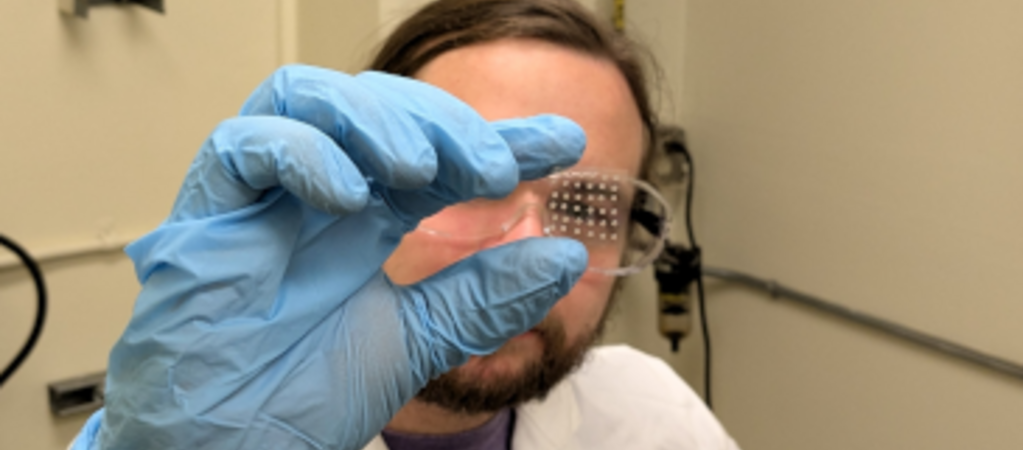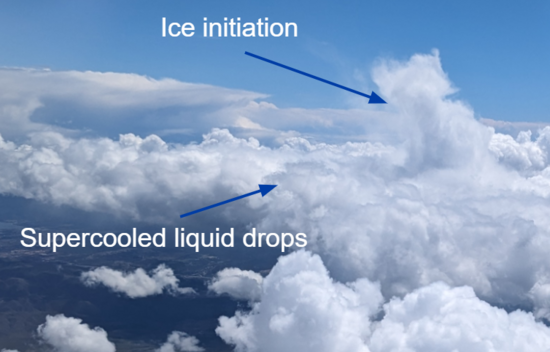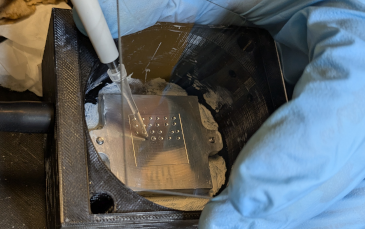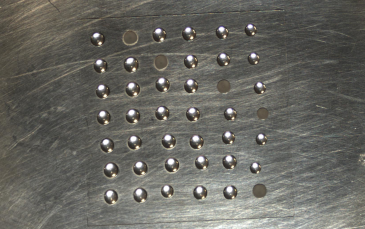
CE-CERT team collaborates with West Texas A&M for low-temperature research
June 27, 2024
The moment when cloud droplets freeze solid is harder to predict than one might think. Droplets of water in the atmosphere may reach -10 to -30 degrees Celcius before freezing. When a cloud undergoes glaciation, a cascade of important thermodynamic and microphysical processes is set into motion. The exact temperature of freezing is a key property to understand and predict the onset of rainfall in convective clouds.

*The fuzzy cloud edges indicate ice formation. The cloud deepening is influenced by the latent heat released during the freezing process. Ice crystals can initiate precipitation or trigger clouds below to begin glaciation at a later stage.
“The cold never bothered me anyway”

Several members of the Petters Aerosol Group and Atmospheric Nanophysical Chemistry lab at CE-CERT will participate in an ice nucleation collaboration with West Texas A&M University. The team spent some weeks in June preparing instrumentation for the project.
The CE-CERT Cold Stage facility loans out the ice nucleation measurement to other research groups and is funded by the National Science Foundation through their Atmospheric and Geospace Sciences Community Instruments and Facilities, or CIF, program.
Sarah Petters, who is serving as the CIF facility manager, expressed her excitement about the shared instrumentation project. She explained, “West Texas A&M will be using it during the fall semester in their curriculum, so I will be visiting them in July to get it running there. It should be an exciting project for the students, who will learn how to build a copy of the instrument.”
The instrument is an ‘open hardware’ instrument, meaning that you can find the build instructions in the publication by CE-CERT graduate student Sunandan Mahant: An open-hardware community ice nucleation cold stage for research and teaching.
“Water does not freeze at zero degrees - it has to freeze onto something, often a microscopic imperfection, to form a solid,” said Sarah. The cold stage freezes an array of liquid droplets as the temperature of the stage is gradually lowered from above freezing to -40 Celcius, providing information on the number of ice-active sites present in that liquid. Ice-active sites provide the start location for water to crystallize, allowing it to freeze.
A delicate task

Placing the droplet array is done carefully by hand before initiating the temperature ramp. “The array had to contain a good set of droplets while not being close enough to join when freezing,” said Paul Holley, a rising senior in Chemical Engineering and undergraduate researcher in the Atmospheric Nanophysical Chemistry lab. “We wanted to keep a consistent, gradual change in temperature over time. This meant some wait time, but the moment of freezing was beautiful to watch,” he added.
A well-traveled instrument
The aerosol group at CE-CERT has been involved in ice nucleation studies for some years. Sunandan has been developing this model since 2022, starting at North Carolina State University, where the group was previously based. “We deployed our instrument last year at Central University of Jammu, India,” says Sunandan. He added, “We are excited for the academic interest by West Texas A&M for a low cost and open source alternative for Ice Nucleating Particles measurements.” They published their ice measurements from Himalayan samples in 2019 in the Journal of Geophysical Research: Characterization of Ice-Nucleating Particles Over Northern India.
Prior to this, the instrument was stress-tested alongside a slew of other techniques from six countries in a series of intercomparison studies. The Fifth International Ice Nucleation experiment was held throughout 2015 at Karlsruhe Institute of Technology in Germany and at Storm Peak Laboratory in Colorado. The third installment, “FIN-03,” was posted for open review in June 2024. The manuscript is under consideration for publication in Atmospheric Measurement Techniques (AMT) (DeMott et al. 2024). The second installment, “FIN-02,” was published in AMT in 2018 (DeMott et al., 2018).
References
DeMott, PJ, JA Mirrielees, SS Petters, DJ Cziczo, MD Petters, HG Bingemer, TCJ Hill, K Froyd, S Garimella, AG Hallar, EJT Levin, IB McCubbin, AE Perring, CN Rapp, T Schiebel, J Schrod, KH Suski, D Weber, MJ Wolf, M Zawadowicz, J Zenker, O Möhler, SD Brooks, The Fifth International Workshop on Ice Nucleation Phase 3 (FIN-03): Field Intercomparison of Ice Nucleation Measurements, Atmospheric Measurement Techniques - Discussions, 2024.
S Mahant, S Yadav, C Gilbert, ER Kjærgaard, MM Jensen, T Kessler, M Bilde, MD Petters, An open-hardware community ice nucleation cold stage for research and teaching, HardwareX, 2023.
S Yadav, RE Venezia, RW Paerl, MD Petters, Characterization of Ice-Nucleating Particles Over Northern India, Journal of Geophysical Research Atmospheres, 2019.
DeMott, PJ, O Möhler, DJ Cziczo, N Hiranuma, MD Petters, SS Petters, F Belosi, HG Bingemer, SD Brooks, C Budke, M Burkert-Kohn, KN Collier, A Danielczok, O Eppers, L Felgitsch, S Garimella, H Grothe, P Herenz, TCJ Hill, K Höhler, ZA Kanji, A Kiselev, T Koop, TB Kristensen, K Krüger, G Kulkarni, EJT Levin, BJ Murray, A Nicosia, D O'Sullivan, A Peckhaus, MJ Polen, HC Price, N Reicher, DA Rothenberg, Y Rudich, G Santachiara, T Schiebel, J Schrod, TM Seifried, F Stratmann, RC Sullivan, KJ Suski1, M Szakáll, HP Taylor, R Ullrich, J Vergara-Temprado, R Wagner, TF Whale, D Weber, A Welti, TW Wilson, MJ Wolf, and J Zenker, The Fifth International Workshop on Ice Nucleation phase 2 (FIN-02): laboratory intercomparison of ice nucleation measurements, Atmospheric Measurement Techniques, 2018.